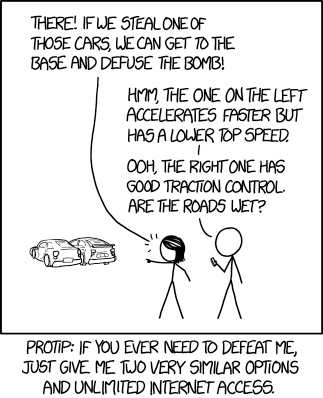Decision Analysis – What to do, what to do?
Decision Analysis is our next Kepner-Tregoe thinking process. The steps provided will be very familiar to anyone who has undertaken a procurement, theft or recruitment exercise, yet they can be scaled down to decision making at an operational level. A key aim of this process is to balance benefits and risks.
1. State Decision
Whilst it may seem obvious to begin with a statement of the decision, setting this out clearly frames all the further steps. Taking Cueball’s dilemma above, this could be stated as “Select one of these two cars to be stolen to travel to the base.” The decision statement should have a choice, an action and a result, but it also implies the previous decisions that have been made – we have already decided to travel to the base, we are going to go by car and it will need to be stolen. Exposing these prior decisions may reveal they weren’t actually considered choices…
2. Clarify Purpose
What do we wish to achieve with this decision? What are our objectives? There may be some mandatory success criteria, and some desirable. Often this will be expanded to a MoSCoW analysis. The mandatory criteria are pass/fail, so they must be specific enough to be assessed and realistic enough to be achievable (or all the options will be rejected!). The desirable criteria are then used if there is more than one option which passes the first stage. These criteria are weighted as some will be more important in choosing which of the minimally compliant options are best.
This is arguably the most critical part of the process, as a clear understanding of the success criteria makes for a better (and more defensible!) decision.
“Must – Get to the base in one piece and in time to defuse the bomb.”
“Should – Be easy to steal.”
“Should – Have good acceleration.”
“Should – Have high top speed.”
“Should – Have good handling.”
“Could – Have a spoiler”
“Won’t – Comply with the Road Traffic Act 1988”
3. Evaluate Alternatives
Megan has neglected to consider alternatives, however normally alternatives would be sought or generated at this stage. Note that the Decision Statement may already preclude certain alternatives…
Now we can assess the alternatives against the mandatory requirement. Whilst Cueball is correct that “do nothing” is a third option, we can reject it quickly as it doesn’t meet our mandatory requirement!
Now we can get to to the Shoulds. The most important of these will be the ability to actually steal the car, as without stealing it, we’ve failed already… The two cars can be scored on each of the weighted desirable criteria – the handling can be given increased weight if the roads are indeed wet. We don’t really care about the body kit, so that will be noted but not scored.
However we’re not going to make the decision at this point!
4. Assess Risks
Risks (as Matt discussed last week) arise from the uncertain. We need to consider what might go wrong with this decision, and there are two sources of uncertainty we’ve already identified. Whilst we can know the relative acceleration and top speed of the cars, we won’t necessarily know how secure they are, or be certain that we won’t crash on the way! On this basis, the slow car we know we can steal might be the better option compared to the fast car that’s difficult to steal. Such uncertainty might have figured into our scoring, but other uncertainty might not. Will the stolen car turn out to be mechanically sound or have enough fuel? Will we get arrested on the way?
5. Make Decision
Finally we can make the decision, based upon the objectives, mandatory and desirable criteria and the uncertainties. If the options are really within a hairsbreadth of each other, then the answer is that either will do… Tossing a coin, picking the simplest or delegating the choice have all been suggested for tiebreakers.
For those of you following along at home, Cueball and Megan should steal both cars and make their way independently to the base (on the assumption they can both steal and drive a car, and can both defuse a bomb)!





Recent comments